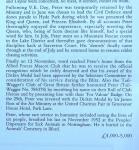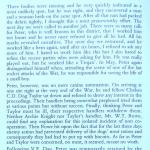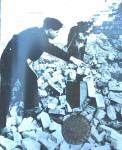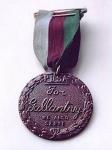-
Posts
13,225 -
Joined
-
Last visited
-
Days Won
22
Content Type
Profiles
Forums
Blogs
Gallery
Events
Store
Everything posted by Mervyn Mitton
-
Captain Albert - we would welcome regular articles from you. I would say - longer then usual posts and with photos - however, not so long that members will lose interest. Looking at Mike's under Medals, I would say that is a good length. We look forward to hearing from you. Do make sure that you IM Brian or, myself - so that we know the article is for 'pinning'. Mervyn
-

Victoria Cross in box
Mervyn Mitton replied to KDVR's topic in Great Britain: Orders, Gallantry, Campaign Medals
Darrell - as the Moderators for the British Section, both Brian and I are sorry to see you acting in this way. I had hoped when I wrote to you last week, that things would settle down and we could get back to Medals. Obviously, we support our Chairman and his Committee, but, never-the-less I personally am sorry to see you leave under these circumstances. The obvious inference is that we keep 'politics' out of our collecting forums . I wish you well for the future. Mervyn Mitton -
A few years ago, one of the most famous medals came-up for sale at Spinks. They wrote a brilliant description of the dog's story and had a good photo. I am going to print it out here - and I challenge you to be honest and admit if you had a small tear when you are finished ? Before I do this, I want to give you some 'compulsory' reading on the cat who was on H.M.S. Amethyst in the Yangtze Incident. Go to Google - type-in Dickins Medals. No. 3 down is ' Simon of H.M.S. Amethyst. The only cat to ever receive this Award.
-
This famous award was instituted in 1943 by Maria DICKIN , who was the Chairlady of the PDSA (Peoples Dispensary for Sick Animals). The purpose was to honour the work of animals in wartime. Remember that the second World War - 1939-45 - had been in progress for 4 years. Terms of award were very strict and had to be authenticated - this quickly established the medal in the eyes of the public - as a Victoria Cross for animals - and it has remained so to the present day. In 1943 the award was only for animals in the armed services and in civil defense. Between 1943 and 1949 only 54 medals were awarded - the Dickins medal was then suspended with War ended. However, in 2002, by Public demand it was re-instituted and the total of awards now stands at 63. Needless to say, the medals can bring very high prices when they come-up for sale.
-
Brian and myself - as joint Moderators for the British Forums - are anxious to have more members researching and publishing good articles. This is not as difficult as it sounds - plan your article - arrange your illustrations and you will find that the writing will flow. Importanly , you will have fine, illustrated stories that will not only look well on GMIC - but, will also give you a publishing base for the magazines. One 'offs' are fine - but, a series at monthly intervals would be better ! We will give you any help that may be required - and the choice of subject is yours - however, it should fall into one of the British categories. Now, how do we say Thank-you. Firstly all articles in this regular series , will be ' pinned' for a two week period for people to see them. Following your title will be a ** Moderators' Choice** - this will remain even when the article is un-pinned. Finally, you will now receive a GMIC Certificate to remember the occasion. SEE ILLUSTRATION BELOW The end result of this is you will receive deserved recognition - and GMIC will have original research and articles. Don't think about it and then forget - we asked Mike earlier this week, and his first article is now pinned on Medals. Brian and Mervyn
-
Mike - Brian and I are most grateful to you for following our request to consider a series of articles for our Medal Forum. We will pin this for 2 weeks to stop it going down the page. You will also be eligible for consideration for a 'Moderators' Commendation. These will be in use in the near future and will be used to draw members' attention to well written and informative Posts. Thank-you for supporting GMIC.
-

Victoria Cross in box
Mervyn Mitton replied to KDVR's topic in Great Britain: Orders, Gallantry, Campaign Medals
UNFORTUNATELY - YOU ARE CORRECT IN THINKING THIS TO BE A COLLECTOR'S COPY. Many people like to have an example in a collection. With Queen's Crown and the then very rare aspect - a genuine one would probably be worth up-wards of 200,000 pounds. -

Ribbon bar question
Mervyn Mitton replied to Noor's topic in Great Britain: Orders, Gallantry, Campaign Medals
The leather pouches are probably for more sensitive equipment - they carried bandages etc., in the white haversack. You will also see they had water bottles. They were never armed. -
This picture show a variety of old lanterns - all with a Police background. I have posted some in the past, but these are the ones still remaining in the collection. On the far right is a candle lantern. The picture on the wall behind shows an old Victorian policeman using his Bulls Eye lantern to go window shopping. Very human and from the Illustrated London News.
-
Well - what did they do when it got dark in the 'old' days ? The simple answer is that they went to bed early and tried to increase the population that had died from malnutrition, disease and warfare. Mankind has faced the problem of darkness since we evolved and it is only in the past 150 years that we have begun to work out solutions. The earliest forms of lighting were burning bundles of twigs - these could be carried - or, tied onto wall brackets. Later, rags could be twisted around a pole and again , could be used in different ways. The Romans and Greeks had invented small clay lamps with cotton wicks - these burned on oil - both vegetable and animal. Europe had candles - animal fats around a wick. These were expensive and the poor used tallow dips - again a scrap of cloth or, a reed - and this was dipped into animal fat. They didn't burn long and were smelly - but, then most of the people were as well ! Dealing specifically with Britain - and even more particularly - England ; the early night watches would light fires at crossroads and it was not until gas was invented in the mid-1800's that large gas lights were hung at intersections. Before then, people ventured out at night only with an escort. You could hire the services of a 'Link Boy' to walk in front of you carrying a flaming torch. You were , of course, personally armed with a sword or, pistols. When the links reached your destination, he extinguished the torch in a special metal inverted cone that householders had by their front steps. Very many still exist on old houses. Householders with money used oil lamps - and this caused the great extinction of whales - as this oil was the preferred type - it didn't smell so bad. Let's go back a 1000 years - you are the Constable of the local Hundred (also, known as the Tything man or, Bourseholder) (a Hundred was approx. 100 households and roughly became a Parish in later days) - you hear a disturbence in the village and if you were brave ventured out to find out why ? There has been a fight in the local Inn - you knew which building as Inns had a branch tied-up outside - and a man has been stabbed. You immediately - following the instructions laid down by the Shire Reeve - call a Hue and Cry. This imposed on every citizen the duty to gather and support the Constable in the hunting down of the criminal. The Shire Reeve was also known as a Sherrif - so, we have words that have survived over a 1000 years - and which are still used in the U.S. - including the Posse. The Sherrif could call a Posse Comitatus to hunt a criminal over a longer distance. So, there you are - with 20 men who are citizens - awaiting your orders - and it is night and dark. Well, the Constable knew where all of his people lived - strangers had to register within a month. With lit torches they would set off - perhaps the constable had a staff - but, the others would have clubs and anything which came to hand. The scene would not be dis-similar to the scenes you sometimes see in films. When arrested the Constable was responsible for bringing him to the Shire Court - he was paid for keeping him in his home. Handcuffs did not exist and a piece of hide or, rope was put round the wrists and tightend with a wooden handle. I think we should look at some types of lanterns that gradually became available for use at night. Remember, ordinary citizens also used these if they could afford the cost - which sometimes makes it difficult to tell which had a peace keeping purpose. The most basic lantern was a Lanthorn. A candle burned inside and the frame was wood in the early days. The panels to allow the light out, were carved from cows' horns - and this was why it had the name lanthorn. Towards the end of the 18th Century (1700's) a metal frame was made and a small oil reservoir with a wick was fixed inside. This had ventilation chimneys and eventually - a sliding panel which could limit the amount of light. The glass at the front was thick and magnified the light - this was the famous 'Bulls Eye' Lantern which was still in use in some Counties in the 1930's. Later, there were carbide lanterns and then some early battery lamps. I suppose that it only in the past 50 years that a constable has had reasonable personal lighting.
-

sporran mount
Mervyn Mitton replied to blueman's topic in Great Britain: Militaria: Badges, Uniforms & Equipment
Hi - Christian - welcome to GMIC. Never too late for comments - you will be amazed at some of the posts that re-surface. You say a piper's sporran - does that mean that they used this copper finish ? I am surprised that it wasn't silver plated - copper corrodes so quickly. Tell us a little about yourself - where you are - what you collect - what sort of work etc. - alwys helps to know a little about the people we correspond with. Mervyn -

E11R Diamond Jubilee 2012
Mervyn Mitton replied to bigjarofwasps's topic in Great Britain: Orders, Gallantry, Campaign Medals
The operative word is - have been - surely that makes retired officers with the required length of service eligible ? -

Ribbon bar question
Mervyn Mitton replied to Noor's topic in Great Britain: Orders, Gallantry, Campaign Medals
A nice set - and the group photo shows you the type of uniform worn. They do a good job at public functions and are usually present at major sporting events. They can be a nuisance - their uniform can be mistaken for a Special Constable's when regulars wore helmets. I can remember a couple of occasions when their supervisors had to be reminded to keep out of the way and stop telling the public what to do - but, that is the odd individual. All Police in the UK have to do a First Aid course - usually run by St. John's' The origins of the Order are also interesting. They were founded to give aid to people going to the Crusades. They were originally the Knights Hospitallers. Driven out - with the Knights Templars - they took refuge on Cyprus - but, were again driven out by the Saracens and ended up in Malta. Their badge became the Maltese Cross. Tucked away in Valetta - the capital of Malta, is the original HQ and Hospital of the Order. They gave their name to Hospitals. -

South Africa Commemorative Medallion Scandanavian Corps At Magersfontein 1899
Mervyn Mitton replied to QSAMIKE's topic in Africa
Mike - it will be very interesting to see what price this fetches ? I notice that some of the threads have become mixed-up with the move - we will have to see if we can clear them? -
How strange that nearly a year later, this has come back. I agree with you Les - great caution is always necessary with 'found' items. However, in the case of the one illustrated in the horrible plastic mould - the person found hundreds of them - he used to mount them like this and sell at markets - but pre 1994. Now Hart's Hill took place during the Siege of Ladysmith and was a major battle - it was also early in the War when the Boers had stockpiles of weaponry and ammo. I am hoping that you can identify the period of the rimless bullets - but, never forget the Boers had plenty of Mausers in the 1st. Boer War of 1881. The Mauser rifle was also equipped to take a bayonet - although the Boers (to my knowledge) never took delivery of them. A large batch with ZAR markings were found in Chile a few years . The .303 was , of course, for the Lee Metford.
-

E11R Diamond Jubilee 2012
Mervyn Mitton replied to bigjarofwasps's topic in Great Britain: Orders, Gallantry, Campaign Medals
Robin - as a retired senior officer is there a possibility you might get the new medal ? Get someone to write to the Honours Dept. and recommend you - it would look good with your others...... Mervyn -

E11R Diamond Jubilee 2012
Mervyn Mitton replied to bigjarofwasps's topic in Great Britain: Orders, Gallantry, Campaign Medals
Craig - congratulations - the Queen gave you an 8o pound medal. I hadn't realised you were so old.......... -

E11R Diamond Jubilee 2012
Mervyn Mitton replied to bigjarofwasps's topic in Great Britain: Orders, Gallantry, Campaign Medals
Craig - what are your others - Golden Jubilee and........... -
Nick - some lovely old helmets - nice for them to be on the Forum. Just so much is being forgotten - and I agree with your comments on badly dressed policemen. My pet hate are the yellow plastic coats - and with 'POLICE' all over them. The public may be stupid, but most of them can tell a policeman. They also must be very hot in Summer ?









